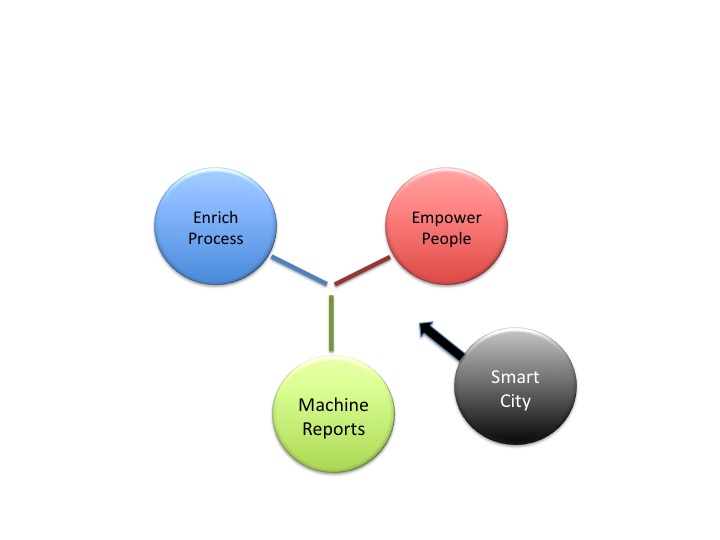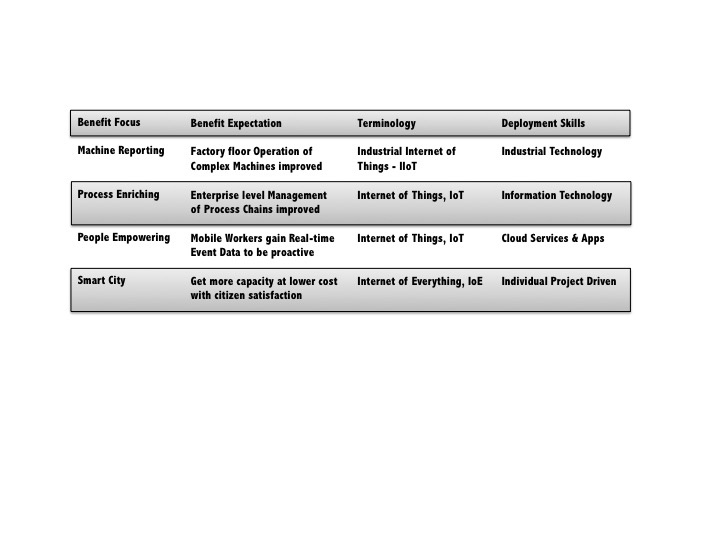Right now it seems as if the entire Technology Industry is saying that the Internet of Things is the next big thing and will change everything for Digital Business. But can someone be more specific about where, and for what reason, my Enterprise should be deploying, or piloting an IoT solution?
For many people it seems as it we are in a hype cycle, something most of us have experienced before when a new technology is initially announced as the answer to everything. The limitations of early deployments cause the initial enthusiasm for the new technology to fall into the ‘trough of disillusionment’, before some clear messages reach the market as to exactly what is really delivered as Business value when deployed in the right way.
In this series of blogs on the Internet of Things, IoT, and the Industrial Internet of Things, IIoT, the focus has been about trying to build much greater understanding and appreciation of exactly what the technology is, and how it works. After all the crucial first stage in planning, where, and why, to use Technology is, of course, to spend time to understand its functionality.
This blog is different, it moves to examining the three principle focuses, or uses, for the Internet of Things, IoT, and Industrial Internet of Things, IIoT, that will provide most enterprises with a clear starting point as to what choices to make to align a deployment with their Business needs. For the sale of completeness the fourth focus that relates to Smart Cities is also included.
The diagram below shows the three individual focuses deliberately separated to indicate the starting point and place where Business value is delivered. In time all three will increasingly interconnect as Digital Business models change the flow of real time information and actions to move around the three in a radial manner, but for first round deployments it is best to stay focused. (Previous blogs in this series detail maturing integration)
 The difficulty of adding a circle to represent a Smart City is due to the difficultly in understanding exactly what to focus upon, as it is a mix of all three-focus segments. A Smart City should embrace and interconnect People, Machines and Processes to deliver both new value and lower costs, but that makes it hard to define other than by individual projects.
The difficulty of adding a circle to represent a Smart City is due to the difficultly in understanding exactly what to focus upon, as it is a mix of all three-focus segments. A Smart City should embrace and interconnect People, Machines and Processes to deliver both new value and lower costs, but that makes it hard to define other than by individual projects.
The term Internet of Everything is often used in connection with the term Smart City to indicate the need to be inclusive of all types of Devices, Services, and People with the functional capabilities of a City.
The other three focuses also introduce particular terms coined by the community driving their adoption, and these terms relate not just their different focus, but also to the skills and capabilities of those communities. Taking each in turn and expanding on their role clarifies this;
1. Machine Reporting
The term Industrial Internet of Things, or IIoT, usually refers to deploying sensors on Industrial Machinery as an extension Industrial, or Operational Technology. This difference is important as it represents products, skills, technologies, architectures and formats, all of which are radically and completely different from those of Office based Information Technology.
An entire environment with specific skills, data formats, communication protocols and architectures has been built up to support Digitally controlled complex production machinery. Extending, and integrating, new supplementary data from being able to add many new low cost sensors to monitor elements of a complex multi function piece of production machinery is the basis for Industrial Internet of Things, or IIoT, projects. The desired outcome, or Business Value lies in operational improvement in throughputs, lower down time, better maintenance, etc. from continuous monitoring of key aspects in (near) real-time.
Industrial Internet of Things, IIoT, focuses on the efficiency of Industrial Machines and is driven by the recognition and desire to manage these expensive assets better.
2. Enriching Process
The generic term Internet of Things, IoT, when used by Information Technology practitioners refers to the ability to add additional data to existing Applications, and thereby improve the business value of an Enterprise Process.
As an example an ERP production-planning application can offer near real-time adaptive capability by using Internet of Things, IoT, sensing at critical elements along the production process to dynamically re-plan the entire production flow in response to reality. The overview of the entire production process from an Enterprise point of view is markedly different from the goal of operating individual production machinery as efficiently as possible.
3. People Empowerment
Increasing the abilities of ‘smart’, or ‘mobile’ workers using cloud based Services, or Apps on mobility devices by providing information on real-time events and situations. It might still be called the Internet of Things, or IoT, but the skills are those of the new wave ‘Digital’ experts.
One of the most marked changes introduced by new technology in the last few years has been the addition of people centric capabilities via Internet based Apps and Services. Usually delivered onto Mobile Devices via Graphical User Interfaces there is less difficulty in integrating the data models, but there has to be more focus on alignment to contextually relevant Services. Sales, Merchandising, or as Service Engineers, and others, have all seen their personal productivity increased, but at the same time they demand a different type of information structure to that of the computer driven machines or processes.
A further characteristic of many of these roles is that they are event responsive, in many cases more so than process driven. A Service Engineer may have a planned round of routine maintenance for the day, but a breakdown will change the plan immediately. Enabling People with increased information about the real-time events in their area of responsibility is an obvious next step.
The Internet of Things, IoT, when applied to providing real-time event information for people through graphical information is a hugely flexible tool as many of the limitations of Machine or Process computer integrations simply don’t apply! BUT remember that this is usually driven from external cloud based Services and is not usually about traditional Information Technology skills.
That said there are other issues; such as complexities of determining who gets what data, from where, as relevant additional information, as well as combining the IoT graphical view with aligned existing legacy date files. As an example a sensor alarm signal from a merchandising machine approaching empty needs to also provide the location details, the type and number of merchandise held, the owner, and similar details.
4. Smart Cities
The flexibility of People driven Internet of Things, IoT, is a key aspect of the first wave of many Smart City initiatives. People can choose Apps that provide Information they want and can interpret the graphical results on their Browser. This conveniently avoids many of the complications of managing the connections, and data flows with complex integrations, whilst still providing new capabilities that offer value to Citizens.
Summary;
Planning to make a first successful move into any of the various forms of Iot/IIoT should be driven by understanding which of the three major focuses will align most successfully with the biggest Business benefit. Having made this decision it is important to note which environment based on what skills are aligned, and choose the project owner and team accordingly. Here is a summary table;

As these early well-focused Business successes develop there will be a natural move towards integration between all three focus groups within the Enterprise. It is wise to make sure that in each of the aligned technology areas there is an IoT/IIoT nominated liaison person who can be kept aware of activities of the other Technology delivery groups. This person can determine if any of the other activities could provide a beneficial link or integration with their own business requirements.


